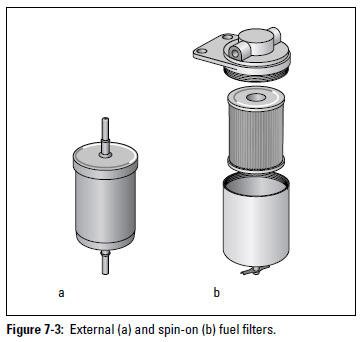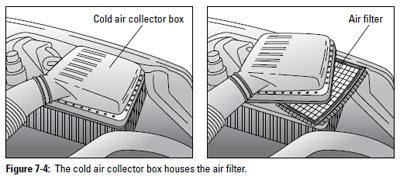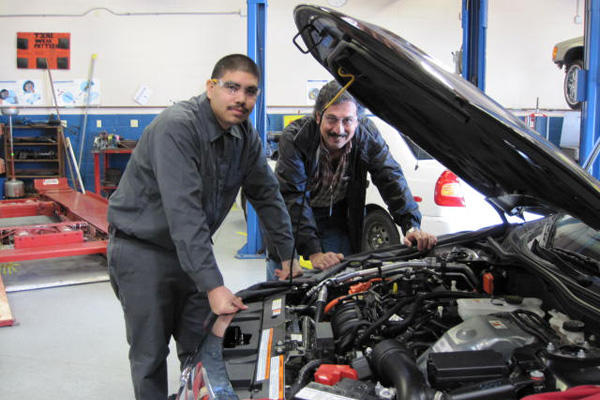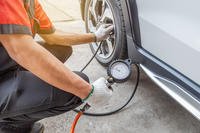Fuel filters do exactly what their name implies — they filter impurities out of the fuel. As the fuel passes along the fuel line on its way to the fuel injectors (or carburetor), it passes through the principal fuel filter. A small screen inside thisfilter traps the dirt and rust that would otherwise foul up your injectors.
If you drive around most of the time with a near-empty fuel tank, the water in the air inside the tank may cause rust to form, contaminate your fuel, and foul up your fuel filter and possibly the fuel injectors.
There's usually a filter screen inside the fuel tank, and some vehicles have additional fuel filters inside the fuel pump, between the fuel tank and the fuel pump, and at the entrance to the throttle body. Figure 7-3 shows two types of fuel filters.

To avoid fouling up your vehicle as well as your vehicle's warranty, it's important to change your fuel filter(s) according to the manufacturer'smaintenance schedule.
Cold Air Collector Box and Air Filter
Because gasoline engines run on a mixture of air and fuel, the air has to be cleaned before it's mixed with the fuel. The air filter removes dirt and dust particles before they can enter the combustion chamber. In the "olden days," most air filters were inside large, round air cleaners that sat on top of the carburetor. Today's fuel-injected engines have a rectangular air filter inside a cold air collector box located near the front of the engine compartment; see Figure 7-4.
To find the rectangular cold air collector box in your vehicle, pop the hood and follow the large air intake duct away from your engine. If you have anolder vehicle with a large round air cleaner, you can't miss it.

The Intake and Exhaust Manifolds
After being filtered in the cold air collector box, air bound for the engine flows through the air intake manifold. This chamber usually is found near the top of the engine; it holds the air under vacuum and admits it into the combustion chamber with the proper amount of fuel. After the fuel/air mixture is burned in the engine, another set of manifold pipes, called the exhaust manifold, carries carbon monoxide and other waste gases away from the engine through the exhaust system for disposal. You usually find the exhaust manifold either lower down on the same side of the engine as the intake manifold or on the other side of the cylinder head.
The Fuel/Air Mixture
In case you're wondering why air is such an important fuel system component, it's because liquid gasoline won't ignite on its own. The pressure caused by the rapid expansion of burning gases is what drives the engine. The only way to get gasoline to ignite is to mix it with air — hence the need for the fuel/air mixture.
Caution: The explosive nature of fuel and air together is why so many accidents occur with near-empty gasoline cans. People tend to think that an almost-empty can of gasoline is harmless, but it couldn't be more dangerous! Gasoline in liquid form will burn but not explode. An air and gasoline vapor combination is more explosive than TNT! Even a seemingly empty can still contains gasoline vapor, and you need only one part of gasoline to 2,000 parts of air by volume to get a combustible mixture! Any kind of spark can set it off.
Caution: Never carry gasoline in anything but a specialized fuel can, and keep that can filled up. What's more, unless you're going far from any source of fuel, don't carry (or store) gasoline at all, and get rid of any old cans you have around.
From Auto Repair for Dummies, copyright © 2009 by Wiley Publishing, Inc., Indianapolis, Indiana. Used by arrangement with John Wiley & Sons, Inc.











